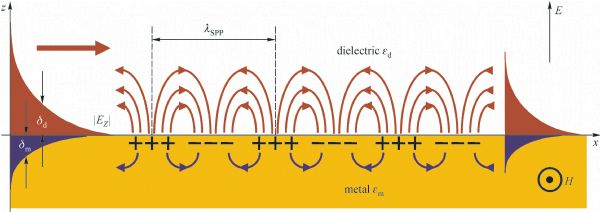
Researchers turn to the field of plasmonics to devise an electro-optic modulator (EOM) small enough to fit on a single chip. Courtesy of Spark On It.
Researchers at the University of Washington in collaboration with ETH-Zurich, Virginia Commonwealth University, and Purdue University, have created an extremely compact plasmonic electro-optic modulator (EOM). This device could reshape modern information technology.
In their paper published in Nature, the team seeks to address limits imposed by signal degradation and energy consumption in long-distance information transfer. Their solution, a “low-loss plasmon-assisted” EOM, is capable of efficiently transmitting large bandwidths at a much faster speed. Researchers have worked for decades to reduce the size of electro-optic devices to fit on a single chip. In order to dramatically shrink high-capacity EO devices, the team turned to a newer field: plasmonics.
Plasmonics in Electro-Optics
The lattice structure of metal crystals contains free electrons that strongly interact with incident light. These electrons will start to oscillate, consequently creating a fluctuating electron density within the metal lattice. This stimulates a plasmon wave which consists of quasiparticles called plasmon polaritons. Plasmonic technologies utilize these mixed photon-electron wave states to concentrate visible light within metal films. This method of data transfer is very different from what we see in commonplace technology. Whereas electronic circuits use the flow of electrons in metal wires, plasmonic data transfer occurs via oscillation of the “light-like” wave. This enables transmission at rates close to the speed of light within a metal film that is just a few nanometers thick.
Subwavelength optical devices could revolutionize the way we approach nonlinear optics, optical nanotweezers, and many biomedical applications. The biggest obstacle with applying plasmonics, however, is the high resistivity losses within the metal. Electron motion within the metal layers convert the light-electron wave energy into heat, therefore leading to great optical loss. In their paper, the research team proposes how to bypass this effect using resonant switching. They demonstrate the success of their approach with a plasmonic EOM.

The above graphic shows how plasmonic polariton oscillate within a waveguide. Courtesy of Frontiers Journals.
Method and Design of the Plasmonic EOM
Using this method, light only couples with the lossy surface plasmon polaritons during the device’s off state. Here, resulting attenuation benefits the system by increasing the extinction ratio between on and off states and enabling sub-picosecond switching. In the on state (out of resonance), destructive interference prevents light from coupling. Rather than directly reducing resonator loss, this method focuses on tolerating loss. The new design allows light to selectively pass through the lossy section, thereby achieving low insertion loss and strong modulation.
The EOM is comprised of a plasmonic ring resonator coupled to a low-loss silicon waveguide. The ring resonator, a gold metal-insulator-metal (MIM) slot waveguide, is filled with an organic electro-optic material to alter resonance conditions due to Pockels effect. By applying a voltage across the waveguide, the researchers were able to control ohmic loss and attenuate the signal.

Metrics of the EOM’s performance and stability are shown above:
(a) Transmittance response to voltage change in the EOM (b) Transmittance sensitivity with wavelength (c) Stability across thermal distribution
Results of Operation
Large information systems need to be able to transmit high bandwidths over large distances without degrading. An ideally designed EOM should be sensitive enough to respond to small electrical fields in order to efficiently carry signals without creating heat. The research team determined the performance of their plasmonic EOM by determining the insertion loss and extinction ratio.
The team observed an insertion loss of less than 3 decibels (dB) and extinction ratio of about 10dB. These results are comparable to those of well-developed CMOS photonic resonators. Due to their plasmonic-driven technique, however, the device dramatically outperforms in terms of transmission rate and bandwidth. It is able to translate electric signals into light at speeds tens of times faster than commercially available technologies. Additionally, the EOM reduces energy requirements by a factor of close to one-thousand while increasing bandwidth capabilities by a factor of ten. Remarkably, the plasmonic-assisted EOM has the width of a human hair.
The international research team successfully combines plasmonics and photonics to create a low-loss electro-optic modulator that could be easily integrated into a single chip system. The plasmonic EOM exhibits strong modulation while maintaining energy efficiency and enabling close to light-speed transmission. This brand new approach to electro-optics marks critical advancement for both digital and analog information processing. Incorporating plasmonics into electro-optics could soon become the new normal for high-speed and high-bandwidth transmission technologies.
